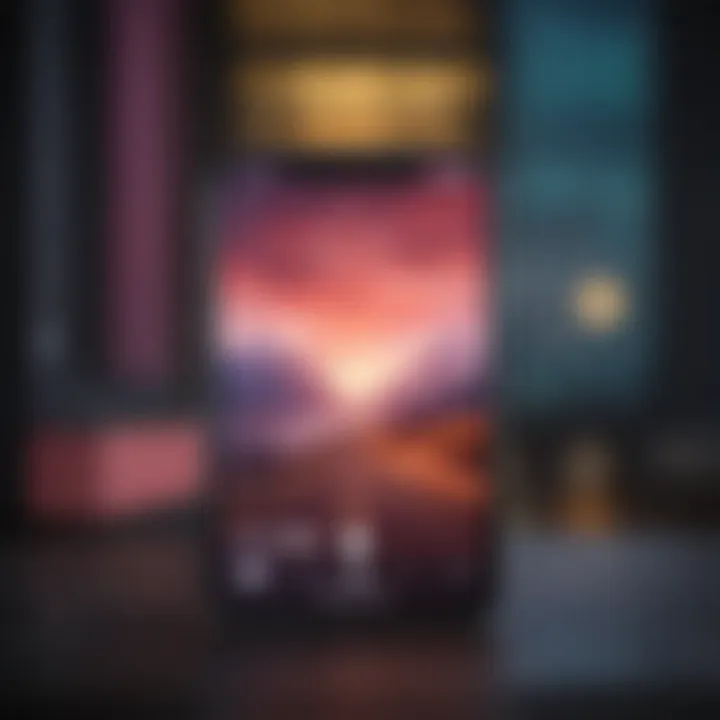Create an Impressive Lock Screen Slideshow on iPhone 11


Product Overview
The iPhone 11 is a noteworthy addition to Apple's lineup, offering a range of features that cater to both casual users and tech-savvy individuals. This smartphone is built on a foundation of powerful hardware coupled with polished software. Featuring the A13 Bionic chip, the iPhone 11 ensures high performance and efficiency, enabling seamless multitasking and demanding applications.
Key Features and Specifications
The iPhone 11 boasts several impressive specifications. It comes equipped with a dual-camera system, which includes a 12MP ultra-wide lens, allowing users to capture expansive photos with rich detail. The device also supports Night mode for low-light capture. Its 6.1-inch Liquid Retina HD display enhances the visual experience with vibrant colors and crisp clarity. Additionally, it supports spatial audio playback and features IP68 water and dust resistance, adding to its durability.
Design and Aesthetics
The design of the iPhone 11 reflects a modern yet classic aesthetic, with an aluminum and glass body that feels premium in hand. Available in multiple colors, the device allows users to express their personal style. The rear camera layout is distinctive, giving the phone a unique look while housing two powerful lenses.
Performance and User Experience
Performance Benchmarks
In terms of performance, the A13 Bionic chip places the iPhone 11 at the top of its class. This chip not only makes tasks faster but also enhances energy efficiency. In benchmarking tests, it consistently outperforms competitors in both CPU and GPU tasks, making it ideal for gamers and resource-intensive applications.
User Interface and Software Capabilities
The iPhone 11 runs on iOS, known for its user-friendly interface. Features such as Face ID, gestures for navigation, and a robust App Store contribute to a smooth user experience. Customizing your device, such as creating a slideshow for your lock screen, is straightforward and allows for personal expression.
User Experiences and Feedback
Users have generally reported high satisfaction with the iPhone 11’s performance and functionality. Many praise the camera capabilities, as well as the ease of use in handling daily tasks. However, some have noted the absence of certain features available in newer models as a potential drawback.
Tips and Tricks
How-to Guides and Tutorials
To set up a slideshow on your lock screen, simply navigate to the settings. Choose your collection of photos and select how you wish them to be displayed. This enhances the visual appeal of your device and offers a personal touch.
Hidden Features and Functionalities
A notable feature of the iPhone 11 is the ability to create memories from your photo library. This option allows for automatic creation of highlights and slideshows based on events or locations, contributing to a rich visual experience.
Troubleshooting Common Issues
In case of any issues with the slideshow feature not functioning as expected, ensure you have the latest software updates installed. Restart your device and double-check your photo selections for any restrictions tied to file formats or sizes.
Latest Updates and News
Recent Developments in Software Updates
Apple frequently updates iOS, introducing new features and improving overall performance. The addition of new photo management features enhances the ways users can organize and display their images.
Industry News and Rumors
There are ongoing discussions about upcoming iPhone releases and features that may be included in future models. Apple consistently innovates, and these advancements often focus on enhanced display options and customization features.
Events and Announcements from Apple
Keep an eye on Apple’s events and announcements for insights into their future products. Apple often reveals enhancements that could improve the current user experience or set trends in the market.
To create your locked screen slideshow, select the photos in the Photos app and set your preferences within the settings menu.
Understanding the Lock Screen Slideshow Feature
The lock screen slideshow feature on the iPhone 11 presents a unique opportunity for users to personalize their device. This functionality allows for a dynamic display of photos every time they unlock their phone. Instead of a static image, users can enjoy a rotating selection of their favorite memories.
Overview of Slideshow Functionality
The slideshow option provides an effortless way to showcase multiple images without requiring constant manual updates. When activated, the iPhone will automatically cycle through the selected photos at intervals chosen by the user. This creates a vibrant and engaging lock screen experience, ensuring that the device feels fresh each time it is viewed. It also enhances the ease of access to cherished photos, turning the lock screen into a gallery. Users can set specific albums or even individual photos to be included in the slideshow, offering flexibility in how they curate their display.
Benefits of Using a Slideshow
Utilizing a lock screen slideshow offers various benefits:
- Personalization: One of the primary advantages is the ability to personalize the lock screen beyond a single image. Users can express their individual style by selecting images that resonate with their interests or experiences.
- Memory Recall: With a slideshow, users frequently look at images that evoke positive memories. This can positively affect mood and serve as a constant reminder of enjoyable moments.
- Freshness: A static wallpaper can become mundane over time. Switching to a slideshow can reinvigorate the phone's aesthetic, making it feel more lively.
- User Engagement: Users may spend more time interacting with the device as they unlock it to see which new image appears. This can enhance the overall experience of using the iPhone.


By understanding these aspects of the lock screen slideshow feature, users can make informed decisions about how to customize their devices effectively.
Prerequisites for Setting Up a Slideshow
Before diving into the process of creating a lock screen slideshow on your iPhone 11, it is crucial to understand certain prerequisites. These elements will ensure that you can fully utilize the functionality of the slideshow feature without running into compatibility issues or setting limitations. A well-prepared setup leads to a smoother experience, allowing you to enjoy the personalized aesthetics of your device.
iPhone Compatibility
The first essential factor to check is whether your iPhone is compatible with the slideshow feature. While the iPhone 11 supports this functionality, it is vital to ensure that your specific model is up to date with the necessary software. The capability to create a lock screen slideshow is generally available on devices running iOS 13 or later. To verify your current iOS version, navigate to Settings > General > About. Here, you will find the software version. If your device is running an earlier version, you will need to update it for the slideshow feature to work properly.
Software Updates Needed
Updating your iPhone’s software is not only essential for security but also for unlocking new features, including the lock screen slideshow. As mentioned, your iPhone should ideally be operating on iOS 13 or later.
To perform an update, go to Settings > General > Software Update. If an update is available, you will see an option to download and install it.
Consider these points while updating:
- Ensure your device is charged or connected to power to prevent interruptions.
- It's advisable to back up your iPhone using iCloud or your computer in case something goes wrong during the update.
- A stable Wi-Fi connection is helpful to facilitate a quicker and safer download.
Updating your software not only enhances performance but can also resolve current bugs or glitches, setting the stage for a seamless slideshow experience. Without these updates, you may miss out on vital improvements that enrich the user experience.
"A well-prepared device is the first step towards an enjoyable customizing journey."
By ensuring your iPhone is compatible and updated, you lay a solid foundation for setting up a lock screen slideshow, paving the way for an engaging personal touch to your device.
Gathering Your Photos for the Slideshow
Before setting up a slideshow for your lock screen, it’s crucial to gather the right photos. The quality and relevance of photos directly impact the appeal of the slideshow. When choosing images, consider collections that resonate with you or encapsulate meaningful moments. This personal touch can elevate the everyday experience of using your device.
Organizing your photos effectively is essential. By doing so, you can streamline the process of selecting images for your lock screen. You can create an album specifically for this purpose, ensuring easy access to your favorite memories every time you unlock your phone.
Selecting Photos from the Library
When selecting photos from your library, aim for quality over quantity. A smaller selection of high-resolution images will create a more visually appealing slideshow. Consider images with similar colors or themes. This can create a more cohesive look when they transition on your screen. Browsing through your camera roll or albums can be time-consuming, so take a moment to reflect on images that evoke positive emotions or memories.
As you select photos, remember that the format matters as well. Portrait orientation images work better for lock screens than landscape-oriented ones. They fill the screen correctly without any cropping issues, leading to a better visual experience.
Creating a Photo Album
Creating a dedicated photo album is a practical step in setting up your slideshow. This method allows you to curate a collection without digging through your entire library each time you want to change your settings.
To create a new album, follow these simple steps:
- Open the Photos app.
- Tap on the "Albums" tab at the bottom of the screen.
- Select the plus sign ( + ) in the top left.
- Choose "New Album" and give it a name of your choosing.
- Add your selected photos to this album.
By organizing your photos into a dedicated album, you can easily manage and update your slideshow. This makes it simpler to refresh the images from time to time, keeping the content fresh and engaging.
A well-curated photo album not only enhances your lock screen experience but also serves as a unique reflection of your interests and memories.
Configuring Slideshow Settings
Configuring slideshow settings is a crucial step in personalizing your iPhone 11’s lock screen experience. These settings will determine how your photos are presented, including transitions and timing. Proper configuration can significantly enhance the aesthetic appeal of your device, creating a more engaging lock screen. It also allows you to reflect your personal taste and preferences.
Accessing Wallpaper Settings
To configure the slideshow settings, the first step is to access the wallpaper settings on your iPhone 11.
- Open the Settings application.
- Scroll down and tap on Wallpaper.
- Select Choose a New Wallpaper. In this section, you have the option to select either a dynamic wallpaper, stills, or your own photo album. This is where you will initiate the slideshow setup by selecting photos you want to include.
Accessing these settings is straightforward, but understanding what options exist here will help you make better choices when customizing your lock screen.
Choosing Slideshow Options
After accessing the wallpaper settings, you will want to choose specific slideshow options to enhance the overall effect. Two important categories under this are Transition Styles and Timing Preferences.
Transition Styles
Transition styles dictate how your images swap from one to another during the slideshow. The smoothness and coherence of transitions contribute to the overall aesthetic you achieve. A popular choice among users is the fade transition as it offers a gentle shift between images, creating a calm viewing experience.
- Key Characteristic: This transition blends one image into another, which is visually appealing.
- Benefits: The fade transition minimizes abrupt changes that might distract the user.
- Unique Feature: The transitions can be adjusted to match the rhythm of how quickly you want images to shift, providing a customizable experience.


In terms of disadvantages, some users may find fade transitions to be too subtle, preferring more dynamic styles like slide or cube. This can depend on personal preference and the type of images used in the slideshow.
Timing Preferences
Timing preferences refer to how long each image will be displayed before transitioning to the next one. Effective timing helps engage users without overwhelming them with too quick transitions. For example, setting a duration of about 5 seconds is often beneficial, allowing enough time to appreciate each image yet quick enough to keep the display dynamic.
- Key Characteristic: Users can select how long each photo remains on screen before switching.
- Benefits: Proper timing enhances the viewing experience by allowing each image to be absorbed fully.
- Unique Feature: This setting is adjustable, giving users the freedom to experiment with shorter or longer display periods according to their taste.
However, long timings may lead to impatience if users are eager to see new images. Conversely, overly short timings may not do justice to images, especially those with intricate details.
"Configuring your slideshow settings to align with your aesthetic preferences can transform the mundane experience of unlocking your phone into an artistic display."
Setting Up the Slideshow as Lock Screen Wallpaper
Setting up a slideshow as your lock screen wallpaper is a critical step in personalizing your iPhone 11. This allows you to showcase a rotating selection of images, transforming your device's appearance every time you unlock it. Not only does this feature enhance the aesthetic appeal of your device, but it also provides a dynamic way to engage with your memory by displaying cherished moments.
The process of applying a slideshow wallpaper builds on the preparation and configuration you’ve already done. It requires understanding both the technical elements involved and the visual impact your chosen images will have on your lock screen. This section will explore how to effectively apply your selected photos as a slideshow wallpaper, ensuring it aligns with your preferences and usage needs.
Selecting photos that resonate with you is pivotal. The ability to connect emotionally with the images displayed is what makes the slideshow feature appealing. Let’s delve deeper into the steps involved in applying the slideshow wallpaper, ensuring you create an experience that reflects your style and keeps your device feeling fresh.
Applying the Slideshow Wallpaper
To begin, navigate to Settings on your iPhone 11. From here, you should select Wallpaper, and then tap on Choose a New Wallpaper. You'll see options to select from your photo library or albums. If you prepared an album specifically for your slideshow, locate it. Once found, select the album, and you will see the option to set it as your wallpaper.
Here is a detailed method to apply the slideshow wallpaper:
- Open Settings: Unlock your iPhone and tap on the Settings app.
- Select Wallpaper: Scroll down and tap on the Wallpaper option.
- Choose a New Wallpaper: Tap on Choose a New Wallpaper.
- Select Your Album: Navigate to your album that contains the selected photos.
- Activate Slideshow Option: Tap on Slideshow if prompted, to ensure your photos will rotate.
- Set to Lock Screen: Finally, tap on Set, and choose Set Lock Screen.
By following these steps, your lock screen will now display a slideshow composed of the photos in the selected album. This process is uncomplicated and allows for significant personalization of your device.
Testing the Slideshow Functionality
After the wallpaper is applied, it is essential to test its functionality. This ensures that the slideshow operates smoothly and displays your images as intended. Testing is more than just a final check; it allows you to experience the visuals in action and see if any adjustments are necessary.
To test the slideshow:
- Lock Your iPhone: Press the side button to lock your device.
- Wake It Up: Tap the screen or press the side button to wake your iPhone.
- Observe the Changes: Observe how the photos transition. Ensure that the timing feels right, and all images display clearly without distortion.
If you encounter issues at this stage, it might be related to the photo quality or settings you chose during setup. Resolving any technical difficulties at this point will enhance your overall experience with the slideshow. Take note of how frequently the images change and make adjustments in the settings if necessary. This is also an opportunity to reflect on whether the selected images resonate with your preferences, allowing for further adjustments in your photo album or slideshow settings.
Managing Your Slideshow Preferences
Managing your slideshow preferences is crucial for optimizing the appearance and functionality of your lock screen. This aspect allows for personalizing your device, making the experience more enjoyable. The adjustments made in this section can lead to a more tailored presentation of your favorite memories. By modifying settings like photo duration and transition effects, you can influence not only how quickly your photos change but also how they visually flow from one to another.
Considerations for Managing Your Preferences
Before diving into specific settings, it's important to consider your personal taste. Do you prefer a quick change of images or a slower, more immersive experience? Understanding what you enjoy helps create a more personalized slideshow that makes your iPhone 11 stand out.
Adjusting Photo Duration
The duration each photo appears on your lock screen is key to the overall experience. Setting a longer duration allows you to fully appreciate each image, especially if they are filled with detail. If you've selected photos that feature intricate scenes or vibrant colors, consider increasing the display time to around five seconds or more. This provides ample time to view the content fully without feeling rushed.
In contrast, shorter durations might be best for dynamic images or if you prefer rapid changes. Keeping photos displayed for two to three seconds can evoke a lively feel to your lock screen experience. Experimentation is important; testing various durations will help you find the right balance for your listening habits.
Changing Transition Effects
Transition effects play a significant role in how smoothly your photos shift from one to another. Apple's iPhone offers a few different effects that can enhance the visual appeal of your slideshow. For instance, a fade effect adds a subtle and elegant feel, whereas a slide effect can give a more dynamic presentation.
When choosing transition effects, consider how they align with your collection of photos. A smoother transition may suit serene landscapes, while a quick, fun transition might benefit a photo album filled with energetic moments.
"Adjusting your slideshow settings is about personalization, ensuring your device resonates with your aesthetic preferences."
Try out various effects and durations during your testing phase. You'll find that certain combinations may enhance the overall appeal of your lock screen, establishing a uniquely customized view each time you unlock your phone.
Culmination
The process of managing slideshow preferences on your iPhone 11 is not merely a matter of aesthetics. These settings allow you to showcase your memories in a manner that is both personal and engaging. By adjusting photo duration and exploring transition effects, you elevate your lock screen experience, connecting deeper with the images you cherish.
Troubleshooting Common Slideshow Issues
Addressing common slideshow issues is integral in ensuring the slideshow functionality on your iPhone 11 operates seamlessly. Users often encounter problems that can diminish the experience or make it frustrating. Understanding these issues allows the user to effectively enjoy the slideshow feature without disruption.
Identifying and addressing these concerns not only enhances user satisfaction but also promotes the longevity of one's device. This section will cover some common problems users might face and provide straightforward solutions to rectify them.


Slideshow Not Displaying
One of the most frustrating experiences is when the slideshow fails to display on the lock screen. This issue can arise due to several reasons. The first thing to check is if the slideshow has been properly set up in the wallpaper settings. If the settings are correct but the slideshow still does not display, consider the following:
- Restarts Help: Restart your iPhone. This simple troubleshooting step can resolve many glitches.
- Software Updates: Ensure that your device is running the latest iOS version. Sometimes, older versions may have bugs affecting functionality.
- Photo Album Availability: Verify that the photo album you selected for the slideshow is not deleted or moved. If the source of the slideshow is not accessible, the slideshow will fail.
In some cases, the device might be overloaded with apps running in the background. Close unnecessary applications to free up system resources which may help in the slideshow being displayed correctly.
Photo Quality Concerns
Another common issue users may face is related to photo quality. When a slideshow plays, the images may appear blurry or pixelated. This affects the overall visual appeal of the lock screen. Understanding the factors that contribute to photo quality in slideshows is vital:
- Resolution of Images: Ensure that the images you are using are of high resolution. Low-resolution images will naturally appear pixelated when displayed on higher resolution screens.
- Network Issues: If you are pulling images from an online source, a weak internet connection can result in poor quality. Download images directly to your device to avoid such situations.
- Compression: Sometimes, during the transfer process, images may get compressed. Use image transfer applications that maintain the original quality.
Regularly inspecting the quality of images can enhance the presentation of your slideshow on the lock screen, making it visually appealing. Consider removing images that do not meet your quality standards and replace them with clearer ones.
Maintaining Your Slideshow Feature
Maintaining the slideshow feature on your iPhone 11 is essential to ensure it continues delivering a fresh and engaging lock screen experience. This feature allows users to display a series of images that can change over time. By regularly maintaining it, you enhance the aesthetic appeal of your device, keep the content relevant, and extend the longevity of the feature itself. A stagnant slideshow can quickly lose its charm; therefore, incorporating regular updates and adjustments is both a necessity and a means of personal expression.
Regularly Updating Your Photo Album
One of the primary steps to maintain your slideshow feature is to update your photo album consistently. This ensures that the images displayed on your lock screen remain interesting and reflect your current preferences. If your slideshow features older images, it may not hold your interest or could evoke stale emotions linked to past memories.
To update your album effectively:
- Add New Photos: Regularly add recent photos that you want to see on your lock screen.
- Remove Unwanted Images: Delete photos that no longer resonate with you or are outdated.
- Organize by Themes: Consider creating themed albums (e.g., travels, family, favorite moments) for a more organized viewing experience.
By keeping your photo album fresh, your lock screen becomes a dynamic element of your device, offering a constant reminder of cherished moments and experiences.
Refreshing Slideshow Settings
In addition to updating the photo album, it's vital to refresh your slideshow settings periodically. Every user has different preferences regarding how images transition and how long they remain visible. Taking the time to adjust these settings ensures that your slideshow maintains your ideal aesthetic.
Some considerations when refreshing your settings include:
- Adjusting Transition Effects: Different transition styles can significantly impact the overall look of your slideshow. Consider trying soft fades or bolder transitions to see which suits your style better.
- Evaluating Timing Preferences: The duration each photo stays on the screen can change how you experience the slideshow. You might prefer quick snapshots, or you may want more time to focus on each image.
*Note: Consistent adjustments to settings can enhance the user experience and adapt the slideshow to your evolving tastes.*
With each update and setting refresh, your lock screen remains in sync with your lifestyle and personal aesthetic. It transforms what could be a mundane aspect of your device into a rich tapestry of visuals that continually engages your senses.
Exploring Alternatives to the Slideshow Feature
The ability to set a lock screen slideshow offers a unique way to personalize your iPhone 11. However, it is equally valuable to be aware of alternatives that can enhance your user experience. These alternatives allow for broader customization, giving users a variety of options to display content on their devices in ways that may better suit their preferences or lifestyle.
Different Lock Screen Styles
Customizing your lock screen is not limited to slideshows. There are many styles you can explore to create a look that resonates with you. For instance, you can opt for a static wallpaper that carries personal significance, such as a favorite travel destination or a heartfelt memory with loved ones. This choice can evoke certain emotions every time you glance at your device.
Additionally, dynamic wallpapers are available. They can change based on interactions or time of day, infusing life into the screen without becoming repetitive. Such wallpapers are often eye-catching and contribute to an engaging interface.
Using built-in themes or colors in the iPhone settings is yet another option. This allows for a cohesive color palette that aligns with your taste or mood. With these alternatives, you maintain a degree of uniqueness while sidestepping the commitment of managing a slideshow.
"Lock screens can be a reflection of one’s personality, and finding the right style is crucial for enhancing the overall experience with your iPhone."
Third-Party Apps for Customization
The third-party app market is rich with options for those looking to customize their lock screens beyond the native capabilities. Applications like Zedge and Walli offer extensive libraries of wallpapers and themes designed by artists. These apps provide high-resolution images, which can elevate the asthetic of your lock screen significantly.
Furthermore, some apps allow for advanced customization features such as enabling animated wallpapers or interactive live wallpapers. Each of these features serves to not only beautify your device but also can redefine how you interact with it.
In addition, several apps offer widget functionalities that allow critical information to appear on the lock screen itself, such as calendar events or weather updates. This integration of functionality can consolidate your needs into one view, making it more convenient to glance at important information without unlocking your phone.
Epilogue: Enhancing Your iPhone Experience with a Slideshow
Creating a lock screen slideshow on the iPhone 11 significantly enhances the user experience. This feature not only adds a personal touch to the device but also serves as a great way to enjoy a rotating display of cherished memories. Each time users glance at their phone, they can see a different image, contributing to a sense of familiarity and connection.
Embracing the slideshow feature allows for greater customization. Users can curate their photo library to reflect personal interests, events, or even inspirational quotes. This makes the device feel more like an extension of one’s personality rather than just a communication tool.
With the right adjustments in settings, the lock screen slideshow can provide an inviting aesthetic. It creates an engaging interface that pleases the eye. Besides visual appeal, the customization options encourage users to explore their photo library. This activity might lead to rediscovering photos that could have otherwise been forgotten.
"A custom slideshow transforms your iPhone from a mere gadget to a canvas of personal storytelling."
Furthermore, the benefits extend beyond mere aesthetics. A well-maintained slideshow keeps the device vibrant and refreshing, which is particularly useful for those who often find themselves staring at the screen throughout the day. Changing these images can elevate mood and provide a sense of novelty, making the device more enjoyable to use.
Ultimately, enhancing your iPhone experience with a slideshow is not just about using a feature; it’s about personalizing a tool that many rely on daily. Taking the time to set it up, manage preferences, and keep it fresh can lead to a more fulfilling interaction with the device. This simple adjustment widens the scope of what an iPhone can represent for its owner, shifting it from a functional object to a collection of valued memories.



